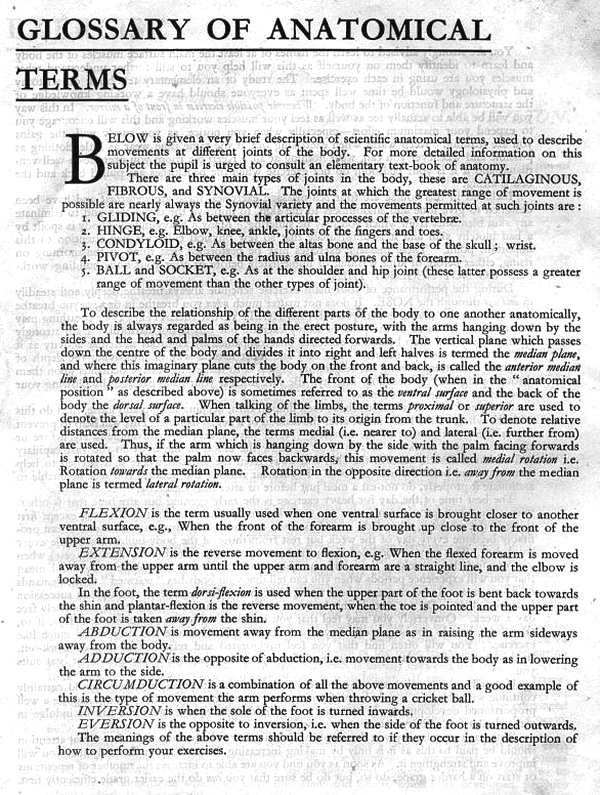scbb10

GLOSSARY OF ANATOMICAL
TERMS
BELOW is given a very bricf description of scicntific anatomical tcrms, uscd to dcscribc movcmcnts at diflcrcnt joints of thc body. For morc dctailcd Information on this subjcct thc pupil is urgcd to consult an elementary tcxt-book of anatomy.
Thcrc arc thrcc main typcs of joints in thc body, thesc arc CATILAGINOUS, FIBRO U S, and SYNOVIAL. The joints at which thc greatest range of movcmcnt is possiblc arc ncarly always the Synovial varictv and thc movcmcnts permitted at such joints are : i. GIJDING, c.g. As between the articular proccsscs of thc verlebne.
2. HINGE, c.g. Elbow, knee, anklc, joints of thc fingers and tocs.
5. CONDYLOID, e.g. As between the altas bonc and thc basc of thc skuli; wrist.
4. PIVOT, e.g. As between the radius and ulna bones of thc forcarm.
5. BALL and SOCKET, c.g. As at thc shouldcr and hip joint (thcsc lattcr possess a greater range of movcmcnt than thc other typcs of joint).
To dcscribc thc relationship of the difFerent parts óf thc body to one another anatomically, thc body is always regarded as being in thc crect posturę, with thc arms hanging down by thc sides and the head and palms of thc hands directcd forwards. The vcrtical piane which passes down thc ccntrc of thc body and dividc$ it into rieht and lcft halvcs is termed thc median piane, and whcrc this imaginary piane cuts thc body on thc front and back, is callcd thc anterior median linę and bosttrior median linę respcctively. The front of the body (when in thc “ anatomical position ” as dcscribcd abovc) is sometimes referred to as thc Penfrai surface and thc back of the body thc dorsal surface. When talking of thc limbs, thc tcrms proximal ot superior arc uscd to denote the levcl ot a particular part of the limb to its origin from thc trunk. To denotc rclativc distanccs from thc median piane, thc tcrms mcdial (i.c. nearer to) and latcral (i.c. further from) arc uscd. Thus, if thc arm which is hanging down by thc sidc with thc palm facing forwards is rotated so that thc palm now faccs baekwards, this movement is callcd media! ro/ałion i.c. Rotation towards thc median piane. Rotation in thc oppositc direction i.c. may from thc median piane is termed lattral rotation.
FLEXION is thc term usually uscd when one ventral surface is brought closer to another vcntral surface, c.g., When thc front of thc forcarm is brought up dosc to thc front of thc upper arm.
EXTENSION is the reversc movcmcnt to flcxion, c.g. When the flexcd forcarm is movcd away from the upper arm until thc upper arm and forcarm arc a sttaight linę, and thc elbow is locked.
In the foot, thc term dorsi-flexion is uscd when thc upper part of thc foot is bent back towards thc shin and plantar-flcxion is ehe rcvcrsc movcmcnt, when thc toc is poimed and the upper part of thc foot is tnken away from thc shin.
ABDUCTION is movcmcnt away from the median piane as in raising thc arm sideways away from thc body.
ADDUCT/ONis thc opposite of abduction, i.c. movcmcnt towards thc body as in lowcring thc arm to thc sidc.
CIRCUMDUCTION is a combination of all thc abovc movcmcnts and a good cxamplc of this is the typc of movcmcnt thc arm performs when throwing a crickct bali.
INVERSION is when thc sole of thc foot is turned inwards.
EVERSION is thc opposite to invcrsion, i.c. when thc sidc of the foot is turned outwards.
The mcanings of the alłove tcrms should be referred to if they occur in thc description of how to perform your cxcrciscs.
Wyszukiwarka
Podobne podstrony:
DSC06984 •^liich ol (lic fołlowing pairs of dnigs cannot bc uscd to (rcal bronchial astlunn7 (A) fon
Below is a page from the Glossary ‘The language of instructions’ from Interactive Homework for Total
usage in New Zealand. A less detailed overview of the NZ table of radio spectrum allocations is give
are shaded in black. A distinct feature of arid upland regions in crystal-line rocks is the very pro
File0032 a 1 Read the text and correct the sentences. I 1 Tom Hanks is not very rich. I 2 You ve Got
The optimal combination of less stringent restrictions with supplementary measures which keeps Rt be
Word Study 1 Word Study WORD STUDY: Stems and Affixes Below is a list of some commonly occurring ste
Word Study 2 Word Study WORD STUDY: Stems and Affixes Below is a list of some commonly occurring ste
Word BankCOMPUTERS and the INTERNET Gtuestion: Which word below is a popular website? Can you think
40,41 O I Letter of referral There are two letters below. One is a letter of referral from a generał
86 J. Ruchel, T. Adamczyk Below is presented an example of building a computational application for
DSC07906 265 Fig. 5. The division of Holocene as proposed by K.D. Jager (1969). The age is given acc
bild1?7 SPARES. A portion of the J.A.P. Works is given ovcr to holding a large stock of replacement
str (76) APPENDIX A GLOSSARY OF RHEOLOGICAL TERMS The exact defmition of many of the terms used in t
A = a b c d then the product of A and B is given by AB = and B = w x V z aw + by ax + bz cw + dy cx
więcej podobnych podstron